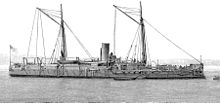
HMVS Cerberus is a breastwork monitor that served in the Victoria Naval Forces, the Commonwealth Naval Forces (CNF), and the Royal Australian Navy (RAN) between 1871 and 1924.
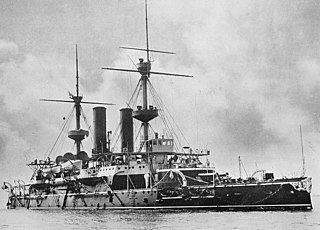
HMS Hood was a modified Royal Sovereign-class pre-dreadnought battleship built for the Royal Navy in the early 1890s. She differed from the other ships of the class in that she had cylindrical gun turrets instead of barbettes and a lower freeboard. She served most of her active career in the Mediterranean Sea, where her low freeboard was less of a disadvantage. The ship was placed in reserve in 1907 and later became the receiving ship at Queenstown, Ireland. Hood was used in the development of anti-torpedo bulges in 1913 and was scuttled in late 1914 to act as a blockship across the southern entrance of Portland Harbour after the start of World War I.

HMS Dreadnought was an ironclad turret ship built for the Royal Navy during the 1870s. Construction was halted less than a year after it began and she was redesigned to improve her stability and buoyancy. Upon completion in 1879, the ship was placed in reserve until she was commissioned in 1884 for service with the Mediterranean Fleet. Upon her return 10 years later, she became a coast guard ship in Ireland for two years. The ship then became a depot ship in 1897 before she was reclassified as a second-class battleship in 1900. Dreadnought participated in the annual fleet manoeuvres for the next two years before she became a training ship in 1902. The ship was taken out of service three years later and sold for scrap in 1908.
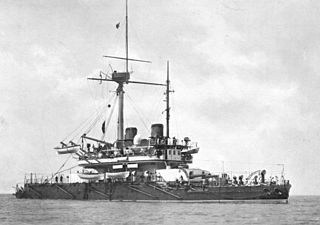
HMS Thunderer was one of two Devastation-class ironclad turret ships built for the Royal Navy in the 1870s. She suffered two serious accidents before the decade was out and gained a reputation as an unlucky ship for several years afterward. The ship was assigned to the Mediterranean Fleet in 1878 and was reduced to reserve in 1881 before being recommissioned in 1885. Thunderer returned home in 1887 and was again placed in reserve. She rejoined the Mediterranean Fleet in 1891, but was forced to return to the UK by boiler problems the following year. The ship became a coast guard ship in Wales in 1895 and was again placed in reserve in 1900. Thunderer was taken out of service in 1907 and sold for scrap in 1909.

The Cerberus-class breastwork monitor was a pair of breastwork monitors built for the Royal Navy in the 1860s.

A breastwork monitor was a modification of the monitor, a warship which was first built in the United States in 1861, designed by John Ericsson and distinguished by the first rotating gun turret, designed by Theodore Timby. The modified design known as a breastwork monitor was introduced by Sir Edward Reed, the Chief Constructor of the Royal Navy between 1863 and 1870. The original monitors were very stable, and difficult to damage by gunfire, because of their very low freeboard. This, however, caused them to behave, some said, as a "half-tide rock", with the ever-present risk of being swamped in a sea should water gain access to the interior through hatches, turret bases or other openings in the deck.

HMS Magdala was a Cerberus-class breastwork monitor of the Royal Navy, built specifically to serve as a coastal defence ship for the harbour of Bombay in the late 1860s. She was ordered by the India Office for the Bombay Marine. The original specifications were thought to be too expensive and a cheaper design was ordered. While limited to harbour defence duties, the breastwork monitors were described by Admiral George Alexander Ballard as being like "full-armoured knights riding on donkeys, easy to avoid but bad to close with." Aside from gunnery practice Magdala remained in Bombay Harbour for her entire career. The ship was sold for scrap in 1903.

HMS Abyssinia was a breastwork monitor ordered, designed and built by J & W Dudgeon specifically for the Bombay Marine for the defence of the harbour at Bombay.

HMS Hotspur was a Victorian Royal Navy ironclad ram – a warship armed with guns but whose primary weapon was a ram.
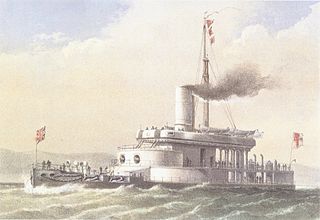
HMS Glatton was a breastwork monitor which served in the Victorian Royal Navy.

HMS Rupert was a battleship of the Victorian Royal Navy, whose principal weapon was designed to be her ram.
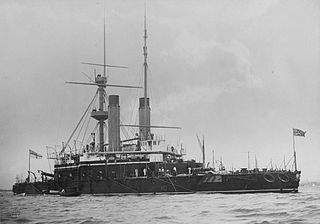
HMS Nile was one of two Trafalgar-class ironclad battleships built for the Royal Navy during the 1880s. Late deliveries of her main guns delayed her commissioning until 1891 and she spent most of the decade with the Mediterranean Fleet. Nile returned home in 1898 and became the coast guard ship at Devonport for five years before she was placed in reserve in 1903. The ship was sold for scrap in 1912 and broken up at Swansea, Wales.

HMS Neptune was an ironclad turret ship originally designed and built in Britain for Brazil, but acquired for the Royal Navy in 1878. Modifications to suit the Royal Navy took three years to complete and the ship did not begin her first commission until 1883 with the Channel Fleet. She was transferred to the Mediterranean Fleet in 1885, but refitted in Portsmouth in 1886–87. Neptune then became the coastguard ship for the 1st Class Reserve at Holyhead until 1893 when she was placed in reserve in Portsmouth. While she was being towed to the breakers in 1903, Neptune unintentionally rammed HMS Victory, then serving as a training hulk for the Naval Signal School, collided with HMS Hero, and narrowly missed several other ships. She was scrapped in Germany in 1904.

The Gorgon-class monitors were a class of monitors in service with the Royal Navy during World War I. Gorgon and her sister ship Glatton were originally built as coastal defence ships for the Royal Norwegian Navy, as HNoMS Nidaros and HNoMS Bjørgvin respectively but requisitioned for British use. Gorgon commissioned first, in June 1918 and bombarded German positions and other targets in Occupied Flanders. She fired the last shots of the war by the Royal Navy into Belgium on 15 October 1918. She was offered for sale after the war, but was used as a target ship when there were no takers. She was sold for scrap in 1928. Glatton was destroyed by a magazine explosion only days after she was completed in September 1918 while in Dover Harbour. She remained a hazard to shipping until the wreck was partially salvaged and the remains moved out of the way during 1925–26.

The Cyclops-class monitor was a group of four ironclad breastwork monitors built for the Royal Navy during the 1870s. They were slightly modified versions of the Cerberus-class monitors. The ships were ordered to satisfy demands for local defence during the war scare of 1870, but the pace of construction slowed tremendously as the perceived threat of war declined. The Cyclops-class monitors spent most of their careers in reserve and were finally sold off in 1903.

HMS Cyclops was the lead ship of the Cyclops-class breastwork monitors built for the Royal Navy during the 1870s. The ships were ordered to satisfy demands for local defence during the war scare of 1870, but the pace of construction slowed tremendously as the perceived threat of war declined. The ship spent most of her career in reserve; her only sustained period in commission was four months in Portland Harbour, during the Russo-Turkish War in 1878 when the British were trying to force the Russians to end the war without allowing them to seize Constantinople. Cyclops was sold for scrap in 1903.

HMS Gorgon was the first ship commissioned of the four Cyclops-class breastwork monitors built for the Royal Navy during the 1870s.

HMS Hecate was the last ship completed of the four Cyclops-class breastwork monitors built for the Royal Navy during the 1870s.

HMS Hydra was the second ship completed of the four Cyclops-class breastwork monitors built for the Royal Navy during the 1870s. The ships were ordered to satisfy demands for local defence during the war scare of 1870, but the pace of construction slowed tremendously as the perceived threat of war declined. The ship spent most of her career in reserve; her only sustained period in commission was four months during the Russo-Turkish War in 1878 when the British were trying to force the Russians to end the war without seizing Constantinople. Hydra was sold for scrap in 1903.

The two British Devastation-class battleships of the 1870s, HMS Devastation and HMS Thunderer, were the first class of ocean-going capital ship that did not carry sails, and the first which mounted the entire main armament on top of the hull rather than inside it.



